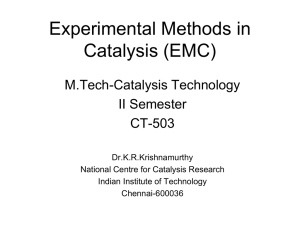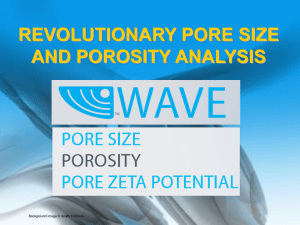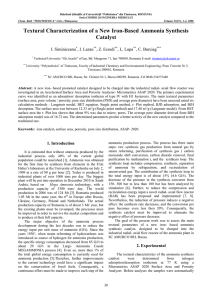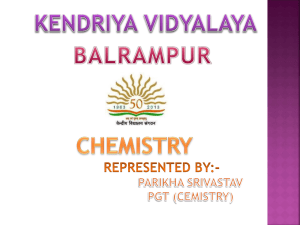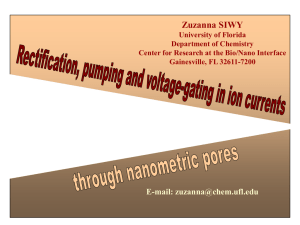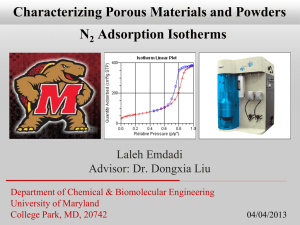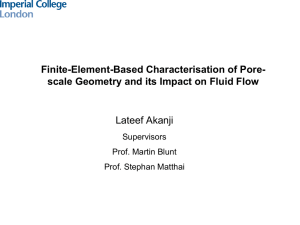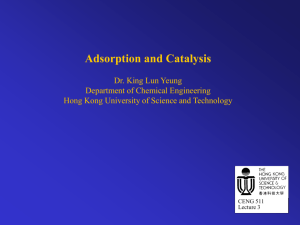MS PowerPoint
advertisement
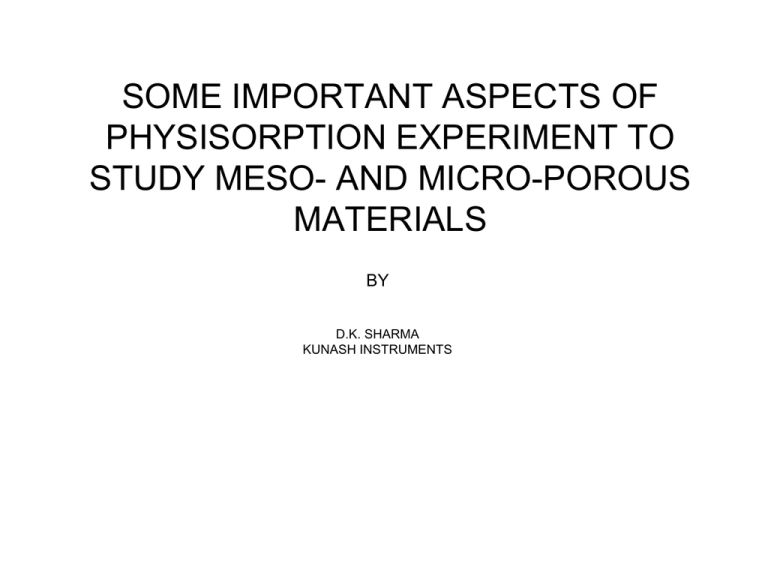
SOME IMPORTANT ASPECTS OF PHYSISORPTION EXPERIMENT TO STUDY MESO- AND MICRO-POROUS MATERIALS BY D.K. SHARMA KUNASH INSTRUMENTS GENERAL PURPOSE OF PHYSISORPTION STUDIES • # SURFACE AREA • # PORE STRUCTURE • # ADSORPTION CAPACITIES GENERALISED SCHEME OF ADSROPTION Vacuum N2 Gas -------------- - ------------- -------- - - - -- - - - ---- -------- ------- ----------------- - - - - - -------- - -- - - - - - - - -- -- --------- - - - - - - - -- - - - - - - - - - - --- - - - - - - - --- - - - - - - ---------------------------------- ------ -- ---- - - - - - - - - - - -- - - - - - -- - - - - -- - - - - - - - - - -- - - - -- - - - - -- - - - - - -- - - - - -- - -- - - -- - - -- - -- - - -- - -- -- - - -- - -- - - - - -- - - - - - - -- - - - - - -- - -- - - - - -- - - - - -- - - - - - XCR 1. 2. 3. Sample tube 4. 5. EVACUATE SAMPLE DOSE N2 GAS MEASURE EQUILIBRIUM PRESSURE CALCULATE VOLUME ADSORBED REPEAT STEP 2 TO 4 REQUIREMENTS • SAMPLE PRESSURE MEASUREMENT • SATURATION PRESSURE MEASUREMENT • VOLUME- ADSORBED----- CALCULATED FROM 1. SAMPLE PRESSURE 2. FREE SPACE ( COLD AS WELL AS WARM ) 3. MANIFOLD PRESSURE AND VOLUME -------------- USING IDEAL GAS LAWS • ALL ABOVE MEASUREMENT AT EQUILIBRIUM CONDITIONS • LONG DURATION OF EXPERIMENTS NH3 Adsorption on MFI Isotherm Plot 3.0 • Ammonia chemisorption 2.5 50 – 350 °C C:\...\DATA\50.SMP C:\...\DATA\75.SMP C:\...\DATA\100.SMP C:\...\DATA\150.SMP C:\...\DATA\250.SMP C:\...\DATA\300.SMP C:\...\DATA\350.SMP Quantity Adsorbed (mmol/g) 3.5 2.0 1.5 1.0 0.5 0.0 0 50 100 150 200 250 300 Pressure (mmHg) 350 400 450 500 550 • Automated sequence to collect the isotherms LOW SURFACE AREA SAMPLES “Free-space” Physical volume that the gas occupies in the sample cell. Vtube-Vsample Free space High ads. Vs. low ads. N N N N N N N N N N N N N N N N N N N NN N NN N N N N N N N N N N N N High ads. N N N N N N N N N NNN N NN Low ads. EFFECT OF FREE SPACE MEASUREMENT ----- ON MESOPOROUS MATERIAL CHARACTERISATION: MEASURED FREE SPACE VALUES WARM COLD 7.3843 BET SURFACE AREA (sqm / g) 23.3026 ENTERED FREE SPACE VALUES WARM COLD 7.1000 23.5800 928 925 TOTAL PORE VOLUME (single point) 2.0294 2.025 AVERAGE PORE DIAMETER (B.J.H) 77.326 76.106 Note: Adsorption measurements are less sensitive to Free-Space errors Contd…EFFECT OF FREE SPACE MEASUREMENT ----- ON MICROPOROUS MATERIAL CHARACTERISATION: MEASURED FREE SPACE VALUES WARM COLD 7.0499 22.1646 ENTERED FREE SPACE VALUES WARM COLD 6.8499 22.3646 LANGMUIR SURFACE AREA (sqm/ g) 1166.7 1164.1 TOTAL PORE VOLUME (single point) 0.4471 0.4442 AVERAGE PORE DIAMETER (B.J.H) 28.014 27.773 Note: Adsorption measurements are less sensitive to Free-Space errors Contd…EFFECT OF FREE SPACE MEASUREMENT ----- ON NON-POROUS MATERIAL CHARACTERISATION: MEASURED FREE SPACE VALUES WARM COLD 5.3433 BET SURFACE AREA (sqm/ g) 15.5229 ENTERED FREE SPACE VALUES WARM COLD 5.4433 15.4229 0.1465 0.2127 TOTAL PORE VOLUME (single point) - - AVERAGE PORE DIAMETER (B.J.H) - - MEASURED FREE SPACE VALUES WARM COLD 7.0592 BET SURFACE AREA (sqm/ g) 22.1050 ENTERED FREE SPACE VALUES WARM COLD 7.1592 22.0050 5.12 6.69 TOTAL PORE VOLUME (single point) 0.0977 0.1000 AVERAGE PORE DIAMETER (B.J.H) 689 510 MEASURED FREE SPACE VALUES WARM COLD 7.5184 BET SURFACE AREA (sqm/ g) 23.8792 ENTERED FREE SPACE VALUES WARM COLD 7.4184 23.9792 6.64 5.22 TOTAL PORE VOLUME (single point) 0.0986 0.0964 AVERAGE PORE DIAMETER (B.J.H) 573 879 Note: Adsorption measurements are highly sensitive to FreeSpace errors SURFACE AREA CALCULATION REWRITING BET EQUATION WITH ADSORBED AMOUNT EXPRESSED IN TERMS OF VOLUME (STP) p / p0 V [ 1 – p/p0 ] = 1 + VmC C – 1 p/ p0 VmC WHERE, V = VOLUME AT STP ADSORBED AT PRESSURE p p0 = SATURATION PRESSURE ( VAPOUR PRESSURE OF LIQUID GAS AT ADSORPTION TEMP) Vm = VOLUME OF GAS (STP) REQUIRED TO FORM ONE MONOLAYER C = CONSTANT RELATED TO ENERGY OF ADSORPTION BET SURFACE AREA CALCULATION WHAT TO LOOK FOR………. a) BET Transform -------- plot linearity b) Y-Intercept --------- +ve c) ‘C’ value --------- (Correlation coefficient > 99.99) > 10 < 300 d) Vm or Qm value within the plotted range e) Aim for uncertainty of Surface area value < 1% NOTE: THE PRESSURE POINTS SHOULD BE SELECTED FOR BET CALCULATIONS IN SUCH A MANNER THAT ALL ABOVE (A TO E) ARE SATISFIED. IF NOT, GO FOR LANGMUIR APPLICATION RESULTS PRESENTATION 1. ISOTHERM STUDIES: a) b) c) d) e) f) g) h) Sample source identification Pre-treatment conditions Nature of Adsorptive used Temperature of Adsorption Mass of the sample used Value of Saturation pressure Type of Isotherm Graphical output Contd……….. 2. SURFACE AREA CALCULATIONS – BET METHOD a) b) c) d) e) f) Sample source Pre-treatment conditions Nature of Adsorptive and Temperature of Adsorption Applicable pressure range ‘C’ value Value of cross sectional area of Adsorptive Note: ENSURE THAT – Y-Intercept is positive –‘C’ value is positive – ‘C’ value is > 10 and < 300 – Linearity coefficient is close to or >99.99 PORE SIZE DISTRIBUTION CALCULATIONS 1- Sufficient number of points in the region of pore activity (between 0.4 – 0.995 p/po ) 2- Selection of t-plot 3- Adsorption branch is to be used for pore size distribution calculations, specially, if networking in pore structure is present (this is many a times identified by Steep desorption branch at the closure point of the Loop PORE SIZE CALCULATION In addition to all the requirements under “Isotherm studies”, the following should be reported: a) b) c) d) Method of pore size calculation T-plot equation used Graphical output: dV / dV vs D dV / DlogD vs D Presence of Micro-porosity, if any, as percent of Total surface area or Total pore volume (From T-plot analysis) WHY WE SHOULD BE CAREFUL WHILE MEASURING LOW PRESSURE NITROGEN ISOTHERM • Nitrogen is more intensely adsorbed at 77k by microporous materials as compared with, say, Argon. • Hydrogen, Neon and Helium do not usually adsorb on microporous materials at 77k. • It is very difficult to obtain, and even more difficult to maintain, nitrogen gas purity better than a few parts per million relative to unwanted H2, He, Ne, Ar, O2, and CO. • Rubber- like polymers used as seals permits (although only slightly) gases to dissolve into them or to permeate completely through them. • Low equilibrium pressures of N2 over microporous materials lead to long equilibrium times. This allows accumulation of significant levels of less adsorbed gases. As a percentage of total pressure reading the damage is very large below 10 millitorr where the non-adsorbed gases may contribute several times as much pressure as the nitrogen. • Use of helium for free space measurement. THEREFORE: • Do not allow Helium or any other five gases to be connected to instrument. Instead valve off the gas source at the regulator and leave a vacuum in the inlet lines. • Use “entered” free space value or try measuring it subsequent to the analysis. • If the manifold has been exposed to helium or any other gases mentioned earlier try an extended pumping down. • If Sample and/or sample tube has been exposed to Helium, trying baking out under vacuum for few hours prior to analysis.


